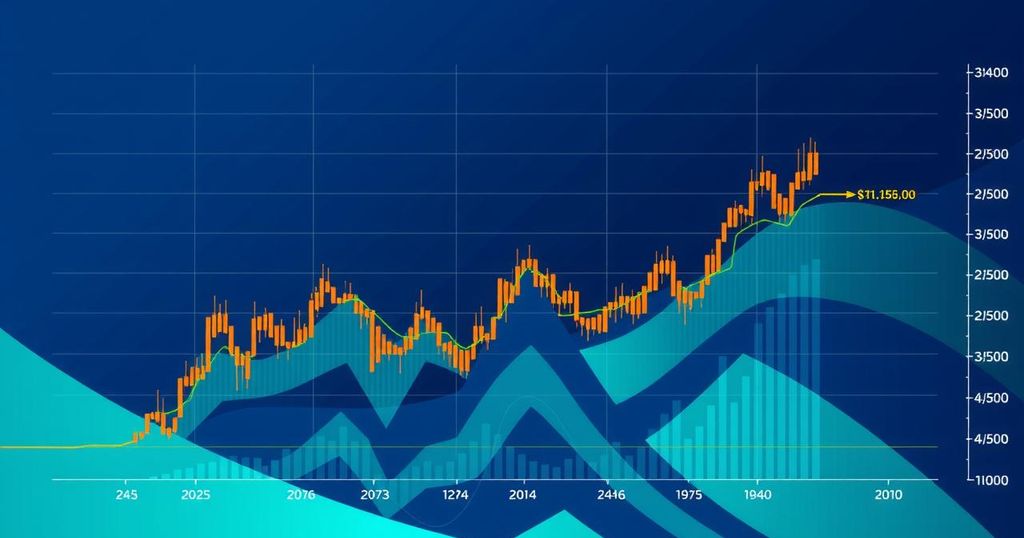Analyzing Bitcoin’s Future: Will 2025 Start with Growth or Decline?
Bitcoin has recently experienced a significant price drop, now sitting at $94,830, down over 12% from its peak. Decreased trading volumes during the holiday season and macroeconomic factors—such as the Federal Reserve’s interest rate decisions and waning ETF interest—are impacting the cryptocurrency. Historically, December sees asset price increases, yet this year has been disappointing, leaving investors hopeful for the ‘January effect’ to spur recovery. Technical indicators suggest critical support levels will be decisive for Bitcoin’s near-term future as it enters 2025.
Bitcoin, the preeminent cryptocurrency, has encountered a notable price correction, recently falling to $94,830, which represents a decline exceeding 12% from its highest monthly value. This downturn aligns with decreased trading activities during the holiday season, as evidenced by a drop in daily trading volumes from approximately $41 billion to $22 billion around December 29. Despite typically witnessing volumes over $100 billion, holiday investor cautiousness has restrained market momentum.
Several market factors are currently inhibiting Bitcoin’s growth. Among these, a notable influence is the Federal Reserve’s recent monetary policy adjustments. In December, the decision to reduce interest rates by 0.25% has instilled a more cautious atmosphere, suggesting a less aggressive easing cycle than previously anticipated. Investors seem hesitant to engage with higher-risk assets, including cryptocurrencies, while reassessing their positions amidst gradual monetary loosening.
Adding to these complications is a decline in institutional investments through exchange-traded funds (ETFs), where 2024 saw a total accumulation of $35.6 billion but with significantly waning inflows. The prospect of the much-anticipated Strategic Bitcoin Reserve has also been met with skepticism, further diluting bullish sentiment within the market.
Historically, December has been a prosperous month for Bitcoin, featuring what was once referred to as the “Santa Claus rally.” However, this year has not reflected that trend, leaving investors disappointed. Consequently, many are now looking toward the anticipated “January effect,” where financial assets often experience gains in the year’s first month as portfolios are adjusted. Despite the promise of the January effect, Bitcoin’s past performance varies; out of the last ten Januarys, it has gained in six, including a modest 0.62% rise last year. February, in contrast, has typically provided more consistent positive momentum.
Technically, Bitcoin currently rests near a significant support level around its 50-day simple moving average, a crucial pivot point historically. Despite recent price weaknesses, the cryptocurrency maintains its position above an ascending trendline established in mid-November, suggesting a potential resilience against further declines. That said, a bearish technical indicator is presenting a rising broadening wedge pattern, which brings increased risk of downside movement. A breach below this pattern’s low could see Bitcoin’s price retreat toward a strong support level at $73,777, previously referenced in March. Alternatively, a bounce from current levels may push Bitcoin to test the $110,000 mark, revisiting the pattern’s upper boundary.
As 2025 approaches, Bitcoin’s immediate trajectory is set to hinge on various macroeconomic factors, overall investor sentiment, and institutional inflows. Regulatory shifts, notably with the introduction of Europe’s Markets in Crypto-Assets (MiCA) framework, may significantly impact market dynamics. The combined effect of these elements will be critical to determining whether Bitcoin regains upward momentum in early 2025 or if it encounters continued consolidation. Investors should remain vigilant as the January effect unfolds, potentially establishing the market’s tone for the forthcoming year.
Bitcoin, acknowledged as the leading cryptocurrency globally, is currently navigating a period of price correction. This situation arises amidst lowered trading volumes typically seen during the holiday season, indicating a decrease in market activity. Moreover, variations in macroeconomic policies, particularly interest rate adjustments from the Federal Reserve and a diminished interest from institutional investors in ETFs, pose significant challenges for Bitcoin’s price recovery and market sentiment. Historically, December is associated with positive price movements for Bitcoin, yet this year’s performance deviates, prompting investors to adopt a cautious outlook as they anticipate potential market behaviors in January, a month characterized by speculative price actions in various financial assets.
In conclusion, Bitcoin’s recent price setback reflects broader market apprehensions influenced by macroeconomic conditions and reduced institutional participation. The absence of the seasonal ‘Santa Claus rally’ has led investors to focus on forthcoming trends associated with the ‘January effect’ and critical technical levels that may dictate future price movements. The interplay of regulatory changes, investor sentiment, and macroeconomic influences will be pivotal in shaping Bitcoin’s path as 2025 begins, ultimately determining whether the cryptocurrency can regain momentum or continues to face consolidation.
Original Source: bravenewcoin.com






Post Comment